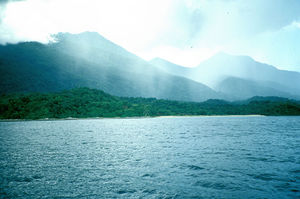Fish/Freshwater habitats
The proportion of fresh water in the world is very small - around two percent. Most of the worlds water is in the oceans. But because of the diverse location, accessibility, and differing qualities of fresh water, the variety of freshwater fishes is vast. Freshwater fishes can cope with a wide range of water locations, qualities, and temperatures, and this adaptability and resilience has made them hardy and very suitable for life in the aquarium.
Types of fresh water
When water falls from clouds as rain, it is conditioned by the earth upon which it lands. This, in turn, affects the local fishes' tolerance of their water conditions. If water falls on a granitic rock its composition is altered very little, and it remains soft. But when it permeates limestone, it absorbs calcium, which makes it alkaline and hard. Peaty soil will acidify water, as will the rotting vegetation typically found in slow moving streams. Fishes from such streams, including most aquarium fishes such as barbs and rasboras, will, therefore, tolerate acidity in their aquarium water. Lakes with no inflow or outflow of water from rivers, as in the Rift Valley of Africa, have a high mineral content that must be emulated in captivity using commercial mixes. Estuarine waters are regularly altered by tidal additions of seawater, and fish from these environments, such as the Mono and the Scat, appreciate a small addition of salt in their water. By the time rain water reaches the sea, it is of an entirely different composition. Once there, it evaporates and begins its journey back through the water cycle.
Effects of temperature
Changes in temperature may also significantly alter the freshwater habitat: where the volume of water is small, the differences between night and day temperatures are greater. More drastic fluctuations include the melting of mountain snows, which add cool water to rivers.
